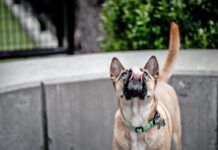A surprising number of dogs won’t eat when their owners aren’t home–but rush to gobble their food as soon as their family returns. The most common reason your dog doesn’t eat when you’re gone is that she’s stressed – and a stressed dog is a cause for concern.
“But my dog doesn’t seem stressed,” you may protest. If your dog is stressed only when she’s left alone, and her stress level is low enough that she’s not acting out in other ways, it may be that you just aren’t there to see the main manifestation of her stress behavior – the fact that she won’t eat when you’re not there.
Dog training professionals often advise clients to leave dogs with a stuffed Kong or other slow-feeding dog toy to keep them entertained and to reduce their stress while their humans are gone. If your dog won’t eat when you’re away you can’t make use of this valuable enrichment tool. And it’s never a god thing when your dog is too stressed to eat!
What to Do About Your Dog Not Eating
First, do a test to see if she’ll eat if another human is present. This will tell you if it’s low-level separation stress (she has to be with you) or isolation stress (she’s okay with any human as long as she’s not alone). Then set up a cell phone, laptop camera, or security camera to take video of her while you’re away to she if she shows other signs of being worried, such as pacing, panting, or vocalizing.
If there aren’t other signs of stress, her worry-level is probably mild, and you may be able to help her with an over-the-counter supplement such as L-theanine (check with your vet first!).
If she’s more distressed, your challenge goes beyond anorexia; you have more than just mild stress. If that’s the case I suggest you seek the assistance of a qualified force-free professional; there are some who are certified to work with separation anxiety; they would have the initials “CSAT” (for certified separation anxiety trainer, certified by separation anxiety specialist Malena DeMartini) or “SAPro” (for a “Separation Anxiety Pro” trainer, certified by Julie Naismith). For more information, I suggest reading Separation Anxiety in Dogs by Malena DeMartini.
Remember, if your dog is stressed, she needs help. Give it to her!





